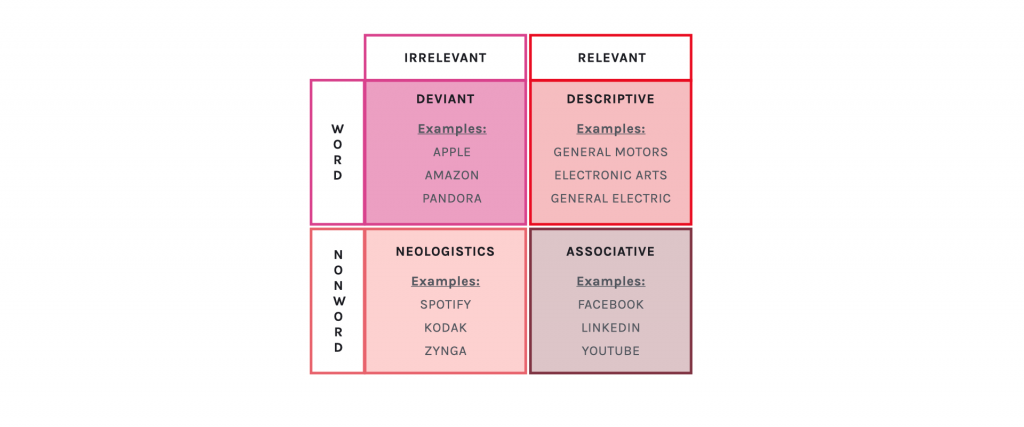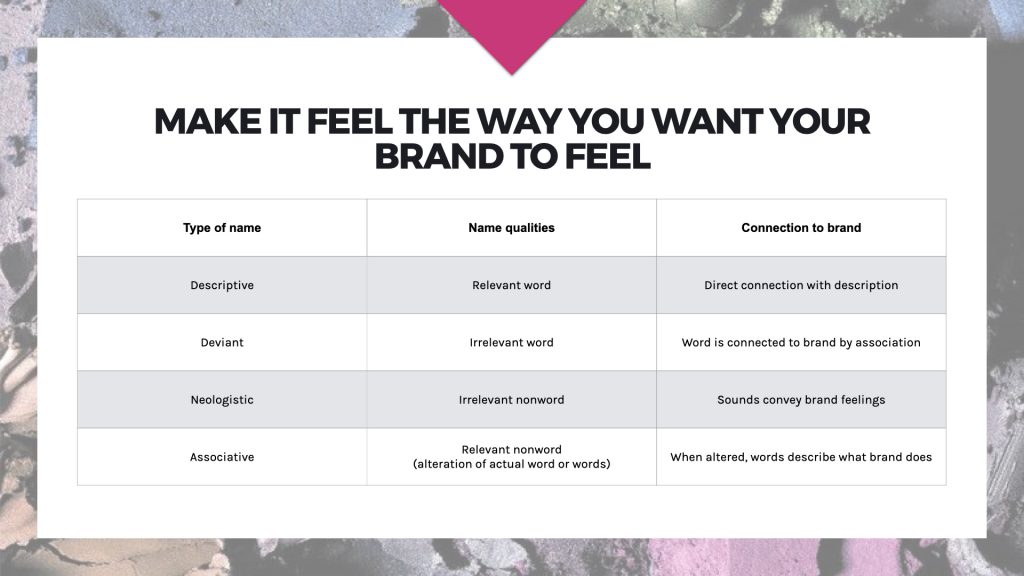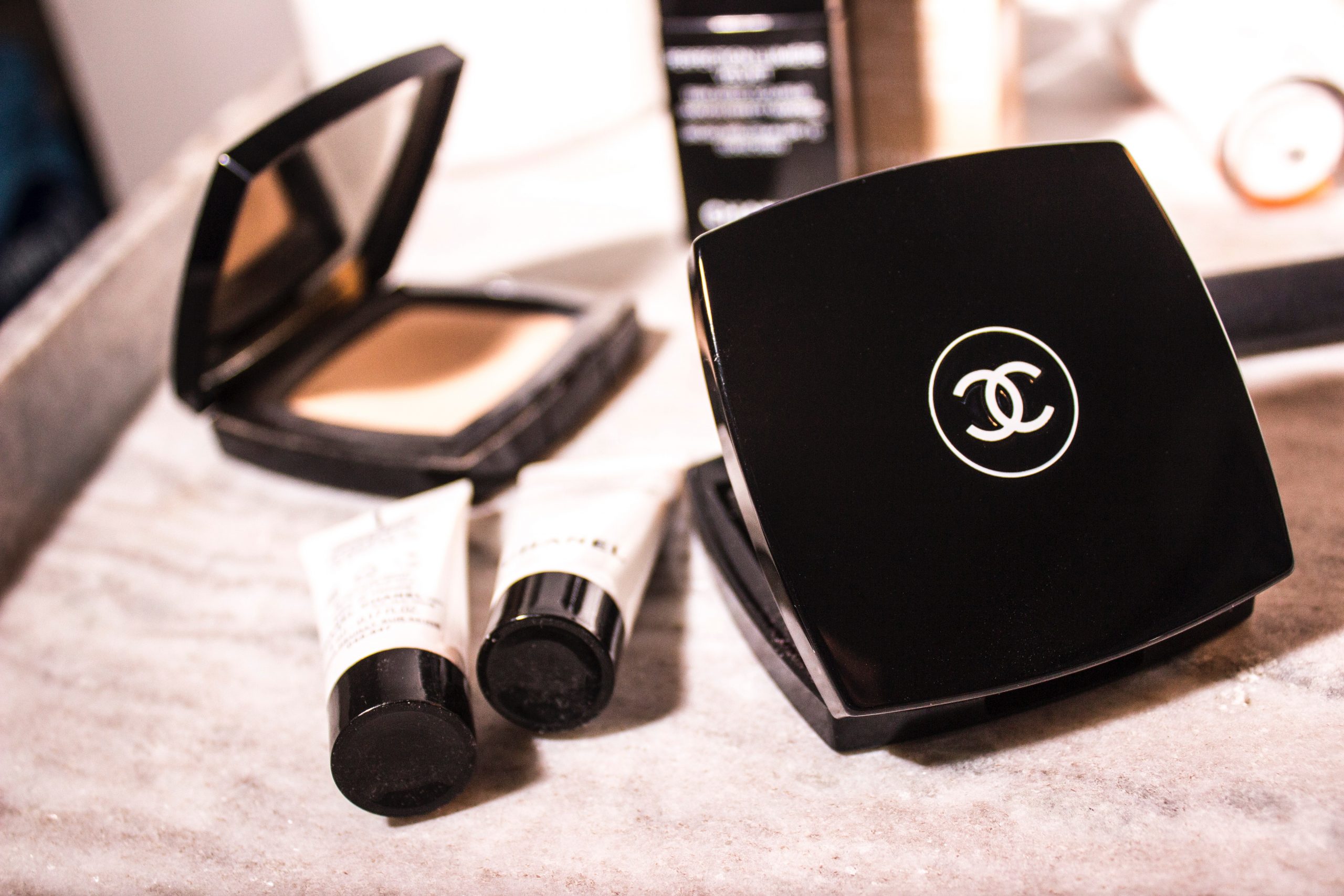So you’ve got your customer avatar, you’ve done competitive research, and you’ve found the niche for your beauty business. Now, it’s time to name it.
Naming your beauty business can feel like such a huge task. And it really is a critical part of your brand, so it’s important to get it right. Take your time; try names out in your head, and see how you like them.
Give the naming process the priority it deserves, but don’t be intimidated. We’re here to help!
Before we jump in with both feet, there’s one thing that’s important to know right off the bat. Be sure you are only considering names that aren’t already trademarked. If you come up with a name you love and want to trademark so that no one else can use it, we’ve got an upcoming post about how to do just that.
4 Types of Business Names

The above graphic, modified from Nick Kolenda’s guide on brand names, shows the 4 types of brand names he identified after extensive research on naming.
- Deviant names are real words, but they aren’t inherently related to the company that chose them. Apple, for example, was a word that was never associated with computers until the company adopted it.
- Descriptive names use naming to explain exactly what a company does.
- Neologistic names aren’t real words at all, and don’t even contain word fragments that relate to the company’s function. Spotify is one good example; it’s not a real word, and none of its component parts relate to music or audio.
- Associative names do have elements that relate to their business, but they aren’t actual words. For example, LinkedIn and Facebook both have component words related to connection and social recognition, respectively.
What’s the best type of brand name to use?

Using another one of Nick Kolenda’s research-based graphics, we can see when each type of brand name works best.
Go back to any lists or notes you’ve made on the qualities that matter most to you in your beauty brand. Your list of core values would work great for this, or any list of qualities that make your brand unique.
See which words in Kolenda’s chart resonate most with you based on your own ambitions for your brand, and consider choosing the recommended type of name. For example, if being memorable is the most important thing for you, you might choose an associative name like Facebook or LinkedIn.
Also, if you’re interested in a step-by-step guide for how to brainstorm each type of brand name, visit Nick Kolenda’s website.
Think about your trademark
I touched on this briefly at the beginning of today’s article, but it’s important to think about trademarking early in the process. When you pick a name for your beauty brand, make sure it’s likely to be accepted for a trademark, The more unique your name is, the better your odds of getting it trademarked down the line.
If you decide on a generic name like “Natural Shampoo” or “Strengthening Nail Polish,” you won’t be able to get it trademarked. Lots of brands use words like this in their branding. You also want to steer clear of names that are overly descriptive, like the above examples, since they aren’t unique enough to be memorable. You want to be sure your customers remember the name of your brand!
Names that suggest the quality of your products are good candidates. But the best candidates for trademarking are neologistic and associative names. Since the words aren’t real, it’s very unlikely that other businesses need to use them. Deviant names are also a good choice for a similar reason. When Apple and Amazon first got started, it’s unlikely that any of their competitors needed to use those words in their own marketing.

What to avoid while naming
A lot of these don’t mesh well with beauty products anyway, but it’s worth mentioning that the following types of names should be avoided while you’re picking a name.
Avoid names associated with:
- Guns
- Tobacco
- Alcohol
- Drugs
- Adult products and services
Why? Well, apart from the fact that guns don’t generally wear (or sell) makeup, use of these types of words can negatively impact your Facebook ads and your Paypal transactions, too. (The government sometimes flags them.) Here’s a full list of words that are prohibited in Facebook ads.
I know all of this because it happened to me with my company, 42 Dubonnet. The name “Dubonnet” refers to a type of wine, and so we couldn’t run Facebook ads without special permission, which was a hassle. We also gave alcohol-related names to some products, and ran into problems using Shopify on Facebook for the same reason. Again, we had to jump through some extra hoops just to market our (non-alcoholic) products.
The original name of the company was Speakeasy Cosmetics. While that may not sound too incendiary, the federal government actually flagged it for review, so we couldn’t transfer funds to pay contractors via PayPal.
Make sure the tone is right
Whatever name you choose, make sure that it connects to your brand in a powerful way. The goal is to make your ideal customer feel something when they hear your brand name.
For instance, if you choose a deviant name (a word that exists but doesn’t directly relate to your product), it should convey an idea about your product on some level. Jeff Bezos named his company “Amazon” after the largest river in the world, because he wanted to build the largest bookstore in the world. In the name “Amazon,” he suggested what shoppers should feel about his company.
With neologistic names, pay close attention to the meanings of word fragments. And for associative names, be sure you’re altering words in a meaningful way that still conveys a clear idea. Pinterest, for example, combined the words “pin” and “interest” in a way that makes the purpose and value of their product clear.
Brainstorming sessions are incredibly useful when you’re trying to identify tone, metaphoric meaning, etc. Write down all the words that you want someone to feel about your brand, then mix and match them, or try to think of other related words that come up for you.
Be Memorable
No one can buy your products if they can’t find you, or if they can’t remember what your brand is called. So, now that you’ve decided on some requirements, it’s time to pick a name (and make sure it’s a sticky one).
This is easier said than done. In their book Made to Stick, Dan and Chip Heath describe an acronym for making your ideas sticky (which essentially means to make them memorable).
That acronym is SUCCESS: simple, unexpected, concrete, credible, emotional, and story.
That sounds like a lot to ask of a name, and it is. But think of all the memorable brands you know that accomplish all of that in just a one-word brand name. Amazon is still a great example here.
Simple
Keep your brand name short and sweet. Challenge yourself to use as few words as you possibly can. This will make it easier to say and remember. And as a bonus, it will take up less real estate on your packaging!
Unexpected
If the type of brand you chose is an associative, neologistic, or deviant one, you’re halfway there. These names are inherently unexpected. Shoot for an element of surprise, something that makes people think a bit. After all, which brand name is more memorable: Urban Decay, or Newport Beach Cosmetics Company?
Concrete
A concrete name is something that you can very easily bring to mind and imagine. Ideally, it triggers one or more of your senses, so that it becomes something almost real. For example, the name of my design company, Creme de Mint, probably makes you think of something you can almost taste. Apple is another good example.
Credible
There needs to be some relationship between your brand name and your products, even if it’s just suggesting the same general feeling.
Emotional
Think early and often about how you want your customers to feel when they hear your name. Are you aiming for a feeling of familiarity and comfort, or excitement and adventure? Those will be two different types of names. Make sure you’re clear on the primary emotion behind your brand, since it’s critical that your name represents that emotion strongly.
Story
Any great branding or marketing strategy tells your customer a story. It takes them on a journey from where they are now to where they want to be. And yes, you can communicate some of that story in a name that’s just one or two words long. The juice company Tropicana is one good example. The story suggested by their name is one of exotic, tropical destinations with swaying palm trees, and the smell of freshly squeezed oranges. The suggestion behind the story is that when you drink a glass of Tropicana, you are transported to that tropical island paradise, even if you’re in a cold place thousands of miles away.
Remember your customers

Your beauty business is your baby, so it’s easy to get swept up in the naming process and to not think past your own desires for the name. But that’s a mistake, because you aren’t the one you’re selling your products to. You’re selling to your ideal customer avatar, and you need to make sure the name you choose resonates with them, too.
Put the ideal customer profile you created in front of you, and brainstorm a list of words that carry meaning for them. Then, match that list with any brainstorming you’ve already done so far on your own. Do you see any common threads? Where do the lists come together? For each name that you like and are testing out in your mind, ask yourself questions from the point of view of your customer.
- Will my ideal customer understand the name?
- How will it make them feel?
- Will they like it, or will it bring up any negative images or emotions for them?
Never forget that your customers are the point of your business, so be sure your name reflects that.
Say it out loud
This might sound silly, but never commit to a name until you’ve said it aloud, by yourself and to other people, Make sure the words sound good, and that they’re easy to say and understand.
Your goal is to have lots of people talking about your beauty business for years to come as they tell their friends and family how much they love it. With that in mind, make sure the words sound good together and when spoken aloud.
Sometimes writing techniques like rhyming or alliteration can help make your name both memorable and fun to say. Even if someone hasn’t tried a brand yet, a fun name can sometimes push them over the edge to making a purchase. The natural deodorant company Meow Meow Tweet is one example of a name that’s fun, memorable, and intriguing—not to mention fun to say aloud.
Brainstorm as many ideas as possible
I’ve talked a lot about brainstorming already, and I’m mentioning it again because it’s just so important. All of the company names listed in this post as examples most certainly came from hours of brainstorming. They weren’t the first knee-jerk reaction to naming the brand.
Creativity doesn’t happen in a vacuum, so once you’ve got a starting point with the lists of names you’ve come up with on your own, look elsewhere for inspiration and see what sticks with you.
As with any brainstorming session, be patient with this process, and don’t worry too much at this stage about what makes sense (or doesn’t).
Here are some ideas to get the inspiration flowing:
Leverage Your Brand-Related Images
Sit down with your mood board, sketches, product samples, sticky notes, and any other images or writing you’ve collected because they feel like a good match for your brand story. Surround yourself with things that convey the feelings and values you want to evoke. Write down all the words that come to mind as you look at these images. You can also use visual brainstorming tools like a visual dictionary or visual thesaurus.
Reference Materials
Use a Thesaurus and search for some of the keywords you’ve written down already. Find synonyms (and maybe even antonyms) that grab you. You can also search for those words in the Thesaurus; this can sometimes lead you to a much more interesting word than the one you started with. Online rhyming dictionaries, or collections of idioms including your keywords are also great sources of inspiration.
Play With Metaphors
Be your own interviewer. Ask yourself questions like, “If my beauty business were an animal, what would it be?” You can do this with just about anything: beverages, foods, locations, plants … There are lots of possibilities here. Get creative about what things, people, and places represent your brand well.
Google It
Do a simple Google search for words and phrases related to your beauty brand. Spend some time in the internet rabbit hole—in this case, it’s actually productive! You might find some associations you’d never have thought of on your own. Make sure to check out the Google Image results, too.
Get Musical
You probably don’t think of iTunes or Spotify as search engines, but for naming your brand, they can be! Search for keywords and see what kinds of song, album, and band names pop up. These are usually catchy and memorable. You won’t want to copy them, of course, but they might inspire you.
Try an Online Name Generator
This can be hit and miss, but if you’ve hit a wall, try out some of the free name generator tools online, like this one from Shopify or Bustaname. There are tons of these name generators out there. Try a few, and see what comes up.
Don’t Work Alone
No matter which tactics you choose, make sure to do this brainstorming session with at least 1-2 other people. These could be your co-founders, or just friends who understand your business goals, if you’re a solopreneur. For brainstorming, two brains are definitely better than one, so make sure you’re working with a group on this one!
Narrow it Down With a Business Name Checklist
After all that brainstorming, hopefully you’ve come with a list of at least a few contenders for your beauty brand name. Ideally, you’ve got a list of 20 or more names that you think might work, with a few favorites sprinkled in.
To help you with narrowing down your choices, here’s a checklist you can use to eliminate some of them.

Business Name Checklist:
- Is the name trademarked? If not, would it be possible to trademark?
- Is it 3 words or less?
- Is it creative? Does it meet the SUCCESS criteria (simple, unique, concrete, credible, emotional, and story)?
- Does it sound good when you say it aloud?
- Is the domain name available at a price you’re willing to pay?
- Are the social media handles available?
- Is the name memorable?
- Is it easy to pronounce and spell?
- Does it carry positive connotations (or, at least, no negative connotations) in all major languages where you’re planning to sell? Use Google Translate to search your name in all major languages spoken in your target market (ex: check French if you’re going to sell in Canada).
If any of the answers on this checklist are “no,” set that name aside. You should end up with 3-5 names that meet all of the above criteria, and that stand out to you as being top choices. Because, after all, you want to make sure you like your brand name!
Get feedback
Hopefully you’ve already gotten some feedback, since you came up with your name by working with 1-2 other people. Now, share the 3-5 names you like best with people who will give you their honest opinions on what they like and don’t like. Ask them to pick which name they like best, if you’re sharing more than one.
You’ll also want to ask:
- Do they like the name?
- Can they pronounce and spell it?
- What does it make them think of?
If you’re truly out for honest feedback, you might get some feedback that’s negative, and that’s okay. If just one person doesn’t like your name, remember that you can’t please everybody; but if it’s a pattern, keep brainstorming names.
Don’t get discouraged if this process takes a while. When you find the right one, it will all be worth it! Also, remember that some of the best names are unusual or unexpected. So, don’t ditch a name you love just because you get a bit of confusion at first. Let people sit with it for a bit.
Want to learn more?
For a start-to-finish look at how to build and grow your beauty business, check out our course, Learn How to Launch a Beauty Product. We cover every aspect of starting a beauty business, from creating a solid foundation and getting funding to manufacturing, branding, sales, and marketing. This guided approach keeps you on track and makes the process feel less overwhelming. To learn more about turning your product ideas into reality, sign up for our newsletters and read more about the course here.

